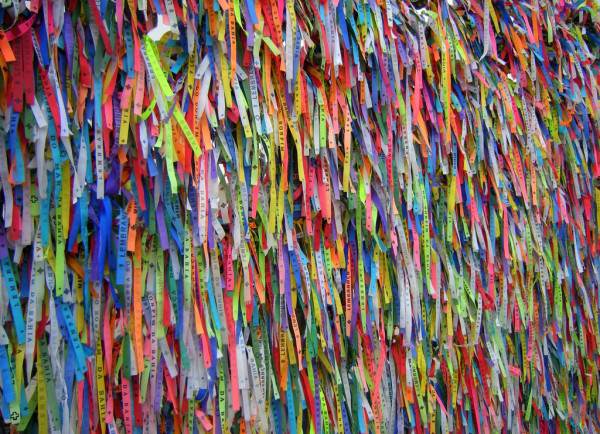My favorite place, easily, in Brazil is the northern district of Bahia. Sure, Rio gets all the fame but here the mix of Spanish and African heritage create an almost tropical, Caribbean feeling.
One thing you will notice if you head to Bahia, or especially to the capitol city of Salvador, are the loads of brightly colored ribbons tied around people’s wrists. Mainly found on tourists, the ribbons are actually called Bonfirm Wish Ribbons and are a famous Brazilian tradition.
The Senhor do Bonfirm Church
The ribbons have a long complicated story that traces back to 1745 and the Church of Bonfirm, located just outside of the city center in Salvador. This church quickly became famous for it’s power to heal and cure. People flocked to the church to pray and would often tie a ribbon, originally around their neck, to remind them of the healing their faith had provided and to help them stay healthy and strong.
It gets even more complicated though when you learn about the role of the Candomblé faith. Candomblé was the religion, outlawed by the Catholic church, that the African slaves adhered to. Originally, as the Catholic church tried to convert the African slaves, they banned the worship of the many African gods and deities. Rather than give up their own gods, the African slaves simply “hid” their gods in the worship of the Catholic saints. As an example, Oxalá, one of the most important African gods, known for his purity and his creation of man, was hidden in the worship of Jesus Christ. Overtime, the church began to except this fusion of the gods, at least unofficially, and Candomblé remains one of the largest religions in Bahia.
Bonfirm Wish Ribbons

The Senhor do Bonfirm Church was one of the centers of this new African-Catholic faith. The church is a Catholic church at heart, but if you look closely, you can see a bit of the Candomblé elements. Bonfirm Wish Ribbons first appeared at the church in 1809 and were originally known as the “Measure of Bonfirm” because they were 47 centimeters long; exactly the length of the right arm of the statue of Jesus Christ displayed on the high altar of the church. The ribbons were tied around the neck and uses sort of like a necklace in that charms and religion images were hung on the string.
Modern Bonfirm, or Wish, Ribbons are more often worn on the left wish and tied three times, representing three wishes. They are stamped with the saying “Lembrança do Senhor do Bonfim da Bahia” which translates to something along the lines of “In Remembrance of the Savior of Bahia.” If you want your wishes to come true, and not curse yourself with bad luck, you must wear the bracelet until it comes off.
The Wish Ribbons are a fun Bahia tradition and I would definitely recommend getting one… but maybe on your way out of town. While the ribbons are suppose to have a religion meaning, they tend to be used by local salesmen and taxi drivers to identify the “newbie” tourists and scream “rip me off.”
Couple Travel Tips
- You aren’t suppose to buy your own Wish Ribbon and you have to have someone else tie it on for you. Some of the hostels in town will offer them out free but if not, the street kids will no doubt try to tie one on and demand a bit of change for the “service.”
- Make sure you are committed to wearing this ribbon for a long, long time. They are suppose to come off in 6 months or so but I had one last over 3 years.
- Consider booking a seat at one of the Candomblé dance shows. You will learn more about this interesting religion and see some of the incredibly beautiful dress designs combining the African gods and Catholic Saints. It’s a bit touristy, but worth it.



